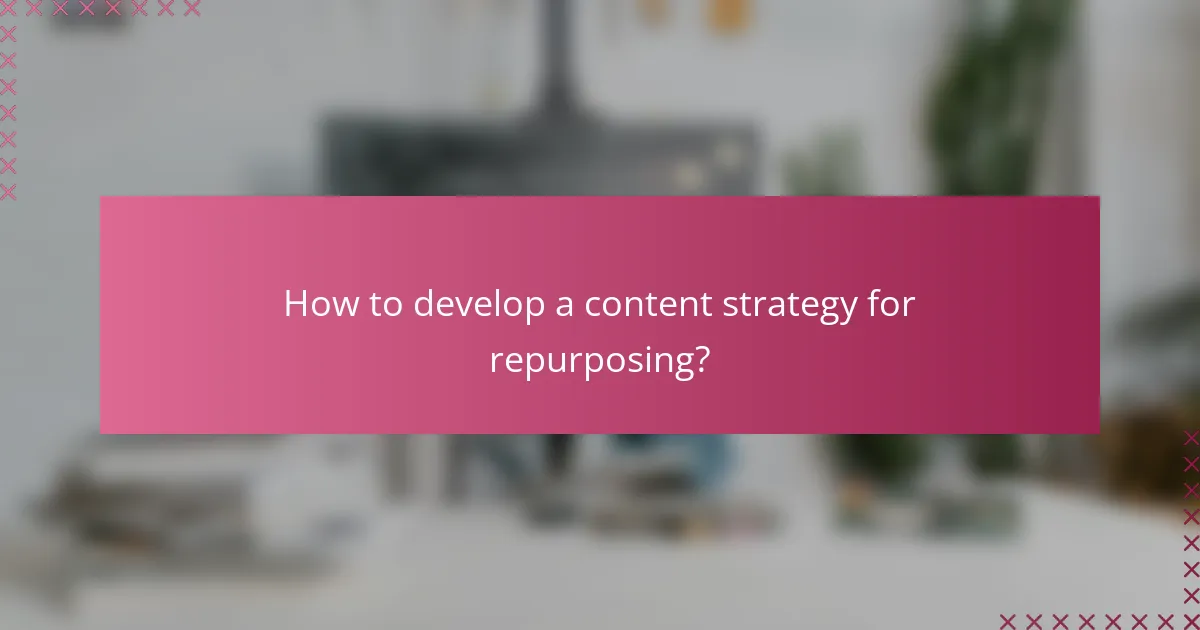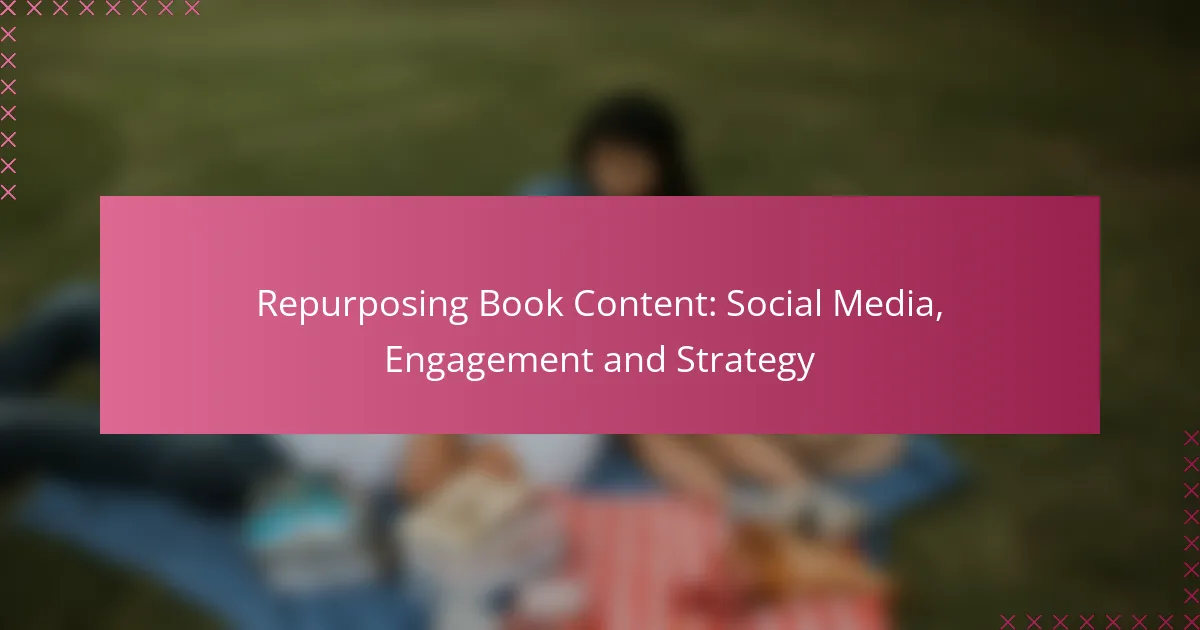Repurposing book content for social media is a powerful strategy to enhance engagement and reach a broader audience. By transforming written material into diverse formats tailored for platforms like Instagram, Twitter, Facebook, and LinkedIn, authors can make their work more accessible and appealing. A well-crafted content strategy that aligns with audience preferences and objectives is essential for maximizing impact and interaction.

How to Repurpose Book Content for Social Media Engagement?
Repurposing book content for social media engagement involves transforming written material into various formats that resonate with online audiences. This strategy enhances visibility and encourages interaction, making your book more accessible and appealing to potential readers.
Utilize quotes and excerpts
Sharing compelling quotes and excerpts from your book can spark interest and encourage shares. Select powerful lines that encapsulate key themes or messages, and pair them with eye-catching visuals for maximum impact.
Consider creating a series of posts featuring different quotes over time. This not only keeps your audience engaged but also reinforces the book’s core ideas, making them more memorable.
Create visual content
Transforming your book content into infographics, images, or short videos can significantly enhance engagement. Visuals tend to capture attention more effectively than text alone, making them ideal for platforms like Instagram and Pinterest.
For instance, summarize chapters or themes through engaging graphics that highlight essential points. Tools like Canva or Adobe Spark can help you design professional-looking visuals without needing extensive graphic design skills.
Engage with interactive posts
Interactive posts, such as polls, quizzes, or questions related to your book’s content, can drive engagement and foster community. These formats invite followers to participate actively, making them feel more connected to your work.
For example, create a quiz based on character traits or plot points from your book. This not only entertains your audience but also encourages them to think critically about your content.
Host live discussions
Hosting live discussions on platforms like Facebook Live or Instagram Live allows you to engage directly with your audience. This format provides an opportunity to delve deeper into your book’s themes and answer questions in real-time.
Promote these sessions in advance and encourage followers to submit questions or topics they want to discuss. This interaction can create a sense of community and investment in your work.
Share behind-the-scenes insights
Offering behind-the-scenes insights into your writing process or the inspiration behind your book can humanize your brand and deepen reader connection. Share anecdotes, challenges, or fun facts that didn’t make it into the final draft.
Consider posting short videos or stories that showcase your writing environment, brainstorming sessions, or even the editing process. This transparency can intrigue readers and make them feel more involved in your journey as an author.

What are the best platforms for repurposing book content?
Repurposing book content effectively involves selecting platforms that align with your audience and content type. The best platforms include Instagram, Twitter, Facebook, and LinkedIn, each serving unique purposes for engagement and outreach.
Instagram for visuals
Instagram is ideal for showcasing visually appealing content from your book, such as quotes, illustrations, or cover designs. Use high-quality images and engaging graphics to capture attention and encourage shares.
Consider creating a series of posts that highlight key themes or chapters, using carousel features to tell a story. Utilize relevant hashtags to increase visibility and reach a broader audience.
Twitter for quotes
Twitter is perfect for sharing impactful quotes or insights from your book. Short, punchy statements resonate well on this platform, making them easily shareable.
Engage with your audience by asking questions related to your quotes or starting discussions around themes in your book. Use threads to elaborate on ideas and connect with followers interested in your subject matter.
Facebook for community engagement
Facebook allows for deeper community engagement through groups and posts. Create a dedicated group for readers to discuss your book, share their thoughts, and connect with you directly.
Post updates, behind-the-scenes content, and host live Q&A sessions to foster interaction. Encourage members to share their experiences and insights, creating a vibrant community around your work.
LinkedIn for professional insights
LinkedIn is suitable for sharing professional insights and thought leadership derived from your book. Publish articles or posts that highlight key findings or lessons relevant to your industry.
Engage with professionals in your field by joining relevant groups and participating in discussions. This approach can position you as an authority and attract a network interested in your expertise.

How to develop a content strategy for repurposing?
To develop a content strategy for repurposing, identify how existing book content can be transformed for various platforms and audiences. This involves understanding your audience, setting specific objectives, and planning your content distribution effectively.
Define target audience
Understanding your target audience is crucial for effective content repurposing. Identify demographics, interests, and pain points to tailor your content accordingly. Consider creating audience personas to visualize and better address their needs.
Utilize tools like surveys or social media analytics to gather insights about your audience’s preferences. This information will guide the tone, format, and channels for your repurposed content.
Set clear goals
Establishing clear goals helps measure the success of your repurposing efforts. Goals could include increasing engagement, driving website traffic, or boosting sales. Make sure these objectives are specific, measurable, achievable, relevant, and time-bound (SMART).
For example, aim to increase social media engagement by 20% over three months by sharing snippets from your book. This clarity will help you focus your strategy and evaluate progress effectively.
Create a content calendar
A content calendar is essential for organizing and scheduling your repurposed content. It helps ensure consistent posting and allows for strategic planning around key dates or events. Include various formats, such as blog posts, social media updates, and videos.
Consider using tools like Google Calendar or Trello to manage your calendar. Plan content at least a month in advance to allow for adjustments based on audience feedback or engagement metrics.
Measure engagement metrics
Measuring engagement metrics is vital for assessing the effectiveness of your repurposed content. Focus on key performance indicators (KPIs) such as likes, shares, comments, and click-through rates. These metrics provide insights into how well your content resonates with your audience.
Regularly review these metrics to identify trends and areas for improvement. Adjust your strategy based on what works best, ensuring your content remains relevant and engaging over time.

What are the key benefits of repurposing book content?
Repurposing book content offers several key benefits, including expanding your audience and maximizing the value of your original work. By transforming your book into various formats, you can engage different segments of your target market and enhance your overall marketing strategy.
Increased reach and visibility
Repurposing allows you to reach a broader audience by distributing your content across multiple platforms. For instance, turning chapters into blog posts, podcasts, or social media snippets can attract different demographics who prefer varied content formats.
Utilizing platforms like Instagram, LinkedIn, or TikTok can significantly enhance visibility. Each platform has its unique audience, so tailoring your content to fit these channels can help you connect with potential readers who may not find your book otherwise.
Enhanced audience engagement
Engaging your audience through repurposed content fosters a deeper connection with your readers. By sharing insights, quotes, or discussions related to your book on social media, you can encourage interaction and feedback, creating a community around your work.
Consider hosting live Q&A sessions or discussions based on your book’s themes. This not only boosts engagement but also positions you as an authority in your field, making your audience more likely to invest in your book.
Cost-effective marketing
Repurposing content is a cost-effective marketing strategy, as it maximizes the use of existing material without the need for extensive new content creation. Instead of starting from scratch, you can leverage your book’s content to create promotional materials, saving both time and resources.
For example, a single chapter can be transformed into several blog posts, infographics, or social media updates. This approach reduces marketing costs while maintaining a consistent message across various channels.
Improved content lifespan
Repurposing extends the lifespan of your content by allowing it to be relevant across different contexts and timeframes. A book can be dissected into various formats that can be shared repeatedly, keeping the content fresh and accessible to new audiences.
Consider creating a content calendar that schedules regular posts derived from your book. This strategy ensures that your work continues to generate interest and engagement long after its initial release, effectively prolonging its relevance in the market.
